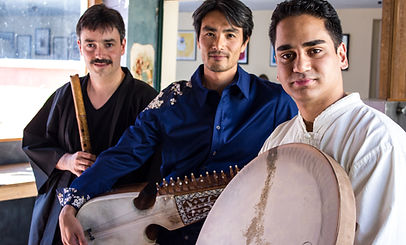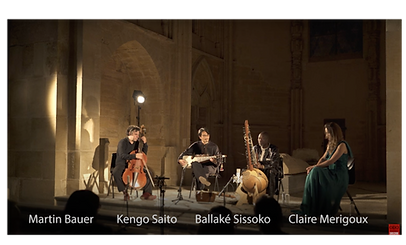

Projets
Kengo Saito mêle son héritage japonais à la musique afghane pour faire jaillir les paysages sonores hybrides de Japanistan, une création inédite ‘made in Paris’. Au concert, le shakuhachi, la flûte traditionnelle japonaise au timbre sublime et aérien, rejoint le son envoûtant du rubab. Et la résonance majestueuse soutenue du daf et du tombak, les percussions persanes, complète la formation en trio. Ensemble ils composent un florilège de mélodies et de rythmes qui parcourt l’Asie dans une expression inédite.

Surbahar, the bass Sitar resonates with its deep sound with long sustains similar to the ancient sound of the Veena, an emblematic instrument of India. Helping to enter the inner state of mind with its extraordinary vibrations. Invitation to a peaceful and resourcing moment.

Layakar ensemble plays mainly original compositions with influences from India, Afghanistan, Iran, Turkey, and Japan. Improvisation is an important part in this project which creats the dynamic and thrilling aspects in concerts. It is the first music project Kengo Saito created with Antoine Morineau (tombak, daff) when he started performing the sitar and the afghan rubâb. Then later developped as a trio and a quartet with Guillaume Barraud (bansuri flute) and Prabhu Edouard (tabla).

Musique néo traditionnelle grecque de la chanteuse Xanthoula Dakovanou, en croisement entre la Grèce et l'Inde.
Xanthoula Dakovanou : musique, paroles, voix
Ourania Lampropoulou : santouri
Guillaume Barraud : bansuri
Kengo Saito : sitar, rubab
Antoine Morineau : tombak, daff, udu
CD "La Dame et La Barque" 2015

Afghan traditional music with the rubâb accompanied by percussion. The haunting sound of the rubâb exposes the meditative raag structures as well as the vivid and sweet folk melodies and the groove of the folk tunes from different regions.

With Sitar or Surbahar (bass Sitar), accompanied by Tabla. The introduction, alap reveals the melodic structure, the color, and the mood of the raag, developing slowly, heading towards complex melodical and rhythmic patterns. This is not for entertainment, but going into an inner world. Tabla joins the rhythmic cycle sections, supporting the development and the flow, exchanging the improvisational parts and excitements.

Les Routes de l'Or, du Mali au Japon.
Tout comme les nomades et les marins se laissaient guider par la même étoile céleste qui les aidait à traverser l’espace et le temps, ce sont les musiciens de ODO Ensemble qui embarquent pour un voyage sur LES ROUTES DE L’OR au Moyen Âge.
ODO Ensemble dans ce voyage, s’aventure aussi à une rencontre entre les musiques modales traditionnelles et les musiques occidentales. Voix, kora, viole de gambe, rubab, sitar.
Quand le royaume du Mali dialogue avec la Corse Génoise, Babylone, Ispahan, l’Afghanistan, les Indes et le Japon, chanteuse et musiciens font vibrer les âmes.
Ces « Musiques Survivantes » valent de l’or, comme un trésor inestimable, si précieux à préserver, héritage immatériel d’un patrimoine culturel et spirituel de plusieurs mondes et de toute une civilisation.

Rencontre entre la chanteuse vietnamienne Huong Thanh et le joueur de kora Ballaké Sissoko. Les chansons vietnamiennes accompagnées par les instrument du Mali et autres (sitar, rubâb afghan).
Le premier concert enregisté à Saigon, Vietnam en 2018 avec Huong Thanh (chant), Ballaké Sissoko (kora), Kengo Saito (sitar, rubâb afghan), et Patric Héral (batterie/percussions).
Sortie CD à venir avec Lansiné Kouyaté au balafon et Alexandre Ngyuen aux percussions.





